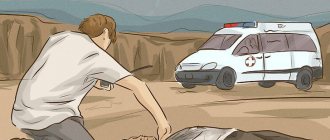Hypothermia: prevention and first aid
| Zulfiya Ravilyevna Galimova physician-therapist |
We present to your attention an interview with a general practitioner, a doctor of the highest category, Zulfiya Ravilyevna Galimova, on the topic: “Hypothermia: prevention and first aid.”
— What is hypothermia? Is this an abstract concept or are there clear criteria for making a diagnosis?
— Hypothermia (or hypothermia) is a condition of the body in which the body temperature drops below that required to maintain normal metabolism and functioning (in humans, below 35°C). This temperature is maintained at an approximately constant level due to biological self-regulation, but under the influence of cold, internal mechanisms may not be able to replenish heat loss.
During hypothermia, the body's metabolic rate decreases, resulting in a decreased need for oxygen. This circumstance is used in medical practice when artificial local or general hypothermia is used. Local hypothermia is used to treat bleeding, injuries and inflammation. General hypothermia of the body is used during heart surgery, in the treatment of traumatic brain injury, and intracranial hemorrhage.
— What changes occur in the body during hypothermia? What are the symptoms?
— Hypothermia, which is fraught with life-threatening consequences, can also occur at ambient temperatures >0 °C if heat loss is higher than heat generation. The most common cause is prolonged exposure to conditions that promote heat loss (immersion in cold water, low air temperature, strong wind, insufficiently warm or damp clothing).
Contributing factors: insufficient heat generation (immobility, including that caused by loss of consciousness), low muscle mass, accelerated heat loss (the influence of alcohol, the presence of burns).
Other causes: endocrine and metabolic - insufficiency of adrenal, pituitary or thyroid function, hypoglycemia; neurological - transverse spinal cord injury, head injury, stroke, neoplasms or inflammatory diseases of the central nervous system, Wernicke encephalopathy, Parkinson's disease; violation of the integrity of the skin - exfoliative dermatitis (erythroderma), severe psoriasis; sepsis; shock; poisoning - ethanol, ethylene glycol, carbon monoxide, hydrogen sulfide, cyanides, nitriles, hypnotics, phenothiazines, opioids, hypoglycemic drugs, cholinergic compounds, α-blockers.
Symptoms - stages of hypothermia (classification of the Swiss hypothermia staging system:
- GT1 - mild: develops when body temperature drops to 32–35 °C, the patient is fully conscious. The condition is characterized by general fatigue, weakness, and drowsiness. Movements are constrained, speech becomes slow, a person pronounces syllables and words separately, the pulse is rare: 60-66 per minute, blood pressure is often moderately increased (up to 140/100 mm Hg). Victims report thirst and chills. The skin is pale, marbled in color, and “goose bumps” appear.
- GT2 - moderate severity: develops when body temperature drops to 28–32 °C. At the same time, consciousness is depressed, the gaze is meaningless, movements in the joints are sharply constrained, breathing is rare, shallow, heart contractions are slower, the pulse is weak, and blood pressure is reduced. The skin is pale, bluish, and cold to the touch.
- GT3 - severe: develops when body temperature drops below 29°C. There is no consciousness, the pupils are narrow, the reaction to light is sluggish or completely absent. There may be cramps in the limbs, and it is difficult to straighten them. The chewing muscles and abdominal muscles are tense. The skin is pale, bluish, and cold to the touch. Breathing is rare, shallow, intermittent. The pulse is rare, weak filling (34-30 per 1 min), blood pressure is reduced or not determined.
- GT4 - body temperature <24 °C, clinical death, no vital signs.
- GT5 - biological death.
— Who is the most confirmed hypothermia, and for whom does it pose the greatest risks? What determines the speed of its onset and degree of severity?
— The risk group is primarily children, the elderly, injured and physically exhausted people. You should always pay attention to those who are intoxicated. It is they who may not fully sense the danger and not ask for help at the right time.
The rapid development of hypothermia in the body is facilitated by low temperature and high air humidity, wind, lack of shelter and warm clothing, insufficient nutrition, dehydration, lack of movement, and illness.
The process of hypothermia occurs most intensely when a person gets into cold water, since the thermal conductivity of water is 27 times higher than that of air. Under these conditions, the body intensively loses heat, which leads to a decrease in body temperature. The safe stay time in water, depending on its temperature, is: 24°C – 7-9 hours; 5-15°C – 3.5-4.5 hours; 0-10°C – 20-40 minutes; -2°C – 3-8 minutes.
— What first aid measures can a person provide to himself, and what can his loved ones do?
— First aid for yourself and your loved ones is well described in the medical manuals:
- Immediately provide conditions to stop heat transfer from the body: pull the person out of cold water, snow, a cold room, open, windy space, lift him from a wet, cold surface.
- Determine the degree of hypothermia and priority measures to provide assistance.
- Warm the victim: take off wet clothes and put on dry, warm clothes and a hat, wrap them in a blanket with an additional heat source, give them a hot drink, if possible, place them in a bath, gradually raising the water temperature to 40C; Taking a warm bath should be stopped when body temperature rises to 34C. In field conditions, containers with hot water, stones heated over a fire, wrapped in fabric can be used for heating. Apply warm objects to the back of the head, groin area, chest, armpits. You can use human body heat. To do this, you need to lie down next to the victim and cuddle up to him. First of all, you need to warm up your torso, and then your arms and legs.
- If the victim is in serious condition (loses consciousness, pulse and breathing are slow or absent), then it is necessary to immediately begin providing first aid, call a doctor or take the patient to a medical facility.
When providing first aid to a victim, it is prohibited to:
- Carry out intensive warming (hot shower, hot bath, hot room).
- Rub a person, as this leads to an influx of cold blood from the periphery to the internal organs and brain, which will continue to cool (warming should go from the center to the periphery).
- Use open fire and alcohol.
- Place the person on a cold base and rub it with snow.
- Should you always seek medical help? Which doctor exactly?
— Any hypothermia is stress for the body. If it was mild and the person does not feel any symptoms, then, in principle, he does not need the help of a doctor. If the temperature drop was more than 32 °C, then it makes sense to call an ambulance or consult a specialist. Mostly in our country, hypothermia/frostbite is dealt with by surgeons/traumatologists/resuscitators.
— What treatment is prescribed for hypothermia?
— Place as quickly as possible in a place or room protected from adverse weather conditions.
— What measures to prevent hypothermia can be recommended for different groups of the population: children, adults, the elderly?
— The following rules can be distinguished:
- To prevent hypothermia, avoid prolonged exposure to the street in cold, windy and humid weather, even if the temperature does not drop below +1°C.
- Do not drink alcohol or psychoactive substances - alcohol intoxication (like any other) causes the illusion of warmth and leads to hypothermia. An additional factor is the inability to concentrate on signs of frostbite.
- Before going out into the cold, you need to eat.
- Do not smoke in the cold - smoking reduces peripheral blood circulation, and thus makes the limbs more vulnerable.
- Wear loose clothing - this promotes normal blood circulation. Dress according to the “cabbage” principle - between layers of clothing there are always layers of air that perfectly retain heat. Outerwear must be waterproof.
- Use the correct shoes. Tight shoes, lack of insoles, and damp, dirty socks often serve as the main prerequisites for the appearance of abrasions and frostbite. You need to put warm insoles in your boots or boots, and wear woolen socks instead of cotton ones - they absorb moisture, leaving your feet dry.
- Do not go out into the cold without mittens, a hat and a scarf. The best option is mittens made of water-repellent and windproof fabric with fur inside. Gloves made from natural materials, although comfortable, do not protect against frost. The cheeks and chin can be protected with a scarf. In windy, cold weather, before going outside, lubricate exposed areas of the body with cream.
- Hiding from the wind - the likelihood of frostbite in the wind is much higher.
- Do not wear metal (including gold, silver) jewelry – rings, earrings, etc. – in the cold. Firstly, metal, due to its high thermal conductivity, cools much faster than the body, as a result of which it is possible to “stick” to the skin or oral mucosa with pain and cold injuries. Secondly, rings on the fingers impede normal blood circulation. In extreme cold, skin contact with metal should be avoided.
- Do not wet the skin - water conducts heat much better than air. Don't go out into the cold with wet hair after a shower. Wet clothes and shoes (for example, a person has fallen into water) must be removed, the water wiped off, if possible, put into dry clothes and the person taken to a warm place as quickly as possible. While in the forest, you need to light a fire, undress and dry your wet clothes, during which time you vigorously exercise and warm yourself by the fire.
- It can be useful for a long walk in the cold to take with you a pair of replacement socks, mittens and a thermos with hot tea. Use a friend's help: Watch your friend's face, especially the ears, nose and cheeks, for any noticeable changes in color, and he or she will watch yours.
- Do not allow the frostbitten area to freeze again - this will cause much more significant damage to the skin.
- Do not remove shoes from frostbitten limbs in the cold - they will swell and you will not be able to put your shoes back on. It is necessary to get to a warm room as soon as possible. If your hands are cold, try warming them under your arms or in your groin.
- If your car stalls far from a populated area or in an area unfamiliar to you, it is better to stay in the car, call for help on your mobile phone, or wait until another car passes on the road.
- In the prevention of frostbite, among other measures, knowledge of the first symptoms that signal the onset of frostbite plays a role - chilliness, tingling, numbness to the point of loss of sensitivity, paleness, coldness of the skin, limitation in the movement of the limbs!
- As soon as you feel hypothermia or signs of frostbite in your extremities while walking, you need to go to any warm place as soon as possible - a store, cafe, entrance, car - to warm up and inspect potentially vulnerable areas.
- When you return home after a long walk in the cold, be sure to check for frostbite on your limbs, back, ears, nose, etc. Left to chance, frostbite can lead to gangrene and subsequent loss of a limb.
- Keep in mind that in children the body’s thermoregulation is not yet fully formed, and in older people and with some diseases it can be impaired. These categories of citizens are most susceptible to hypothermia and frostbite, so this should be taken into account when planning a walk. When letting your child walk outside in the cold, remember that it is advisable for him to return to the warmth and warm up every 15-20 minutes.
Therapist Zulfiya Ravilyevna Galimova receives appointments at the Miracle Doctor clinic - Moscow, st. Shkolnaya, 49.
Interview prepared by: Maria Zelenskaya, Head of Public Relations of the Association of Medical Journalists, Chief Editor of the Digest of the Academy of Obstetrics and Gynecology magazine
Causes of hypothermia
Causes of hypothermia:
- Negative air temperature;
- High humidity;
- High wind speed (at 5 m/s, heat evaporates from the skin 2 times faster, at 10 m/s – 4 times);
- Clothes that are out of season, refusal to wear a hat or gloves;
- Shoes that are the wrong size, or made of rubber, or with too thin soles;
- Wearing synthetic clothing in the cold season;
- Prolonged immobility in the open air;
- Intoxication, in which the blood vessels are dilated, due to which the warm blood coming from the heart quickly cools down in the periphery, and then cools the heart and internal organs, in addition, the reactions of the central nervous system are slowed down, and a drunk person can fall asleep in the open air and not wake up .
Factors that increase the risk of hypothermia:
- Following a strict and unbalanced diet;
- Vitamin deficiency in the diet;
- Chronic fatigue;
- Long-term stress;
- Constantly low blood pressure;
- Long-term somatic or infectious disease leading to exhaustion, lack of fat and muscle tissue;
- History of heart failure, as blood thickens in the cold and it is difficult for the heart to pump it;
- Presence of cancer;
- Adrenal insufficiency (Addison's disease), one of the symptoms of which is low blood pressure, which reduces the rate of blood circulation;
- HIV – infection;
- Hypothyroidism, due to which the activity of the thyroid gland, which is responsible for maintaining normal body temperature, is reduced;
- Liver cirrhosis, in which the functional tissue of the organ is replaced by fibrous fibers;
- Acute and sudden loss of blood, to which the body does not have time to develop a compensatory response;
- Traumatic brain injury with loss of consciousness.
Treatment of hypothermia in a hospital
Of course, a person with signs of hypothermia who is found unconscious and with minimal signs of life should be sent to the hospital.
There are other good reasons for hospitalization for hypothermia:
- Hypothermia of a child or elderly person;
- Determination of arrhythmic pulse;
- The presence of signs of frostbite of any, even minimal degree, especially if there is a history of diabetes mellitus, obliterating endarteritis, trophic ulcers, atherosclerosis of the lower extremities;
- Stage 2-4 of hypothermia was noted;
Algorithm for providing medical care:
- A person suffering from hypothermia is placed on a mattress filled with warm water.
- Solutions heated to 37 °C or slightly higher are administered intravenously.
- To ensure proper breathing, patients are given a mask with humidified oxygen; if they are unconscious, they are put into therapeutic sleep with an injection of Sibazon and sodium hydroxybutyrate, then transferred to artificial respiration using a forced ventilation device.
- Defibrillation is performed according to indications.
- A mandatory measure when restoring a patient’s vital functions in stage 3 of hypothermia is to connect him to a heart-lung machine, which increases body temperature by 1° every 3 minutes. In difficult cases, an operation is performed to wash the internal organs with warm saline solution.
- Administration of drugs that stimulate cardiac activity.
- Installation of an artificial pacemaker that provides ventricular defibrillation.
- Prevention of vascular spasm by administering antispasmodics after restoration of heart rhythm.
- Administration of painkillers when pain occurs after frostbite and vasospasm.
- Stimulation of heart nutrition with the help of vitamins and antihistamines.
After a frozen person arrives at the hospital, doctors use an electronic sensor placed in the rectum to monitor body temperature. Its decrease in the first time after a person warms up is considered normal, because cold skin and subcutaneous tissue cool the entire body and internal organs. With the correct administration of warm saline every 15 minutes, body temperature rises by 1°.
At the same time, heart rate, blood pressure, and respiratory rate are monitored. To do this, an ECG is performed or a cardiac monitor is installed to monitor the heart rhythm.











